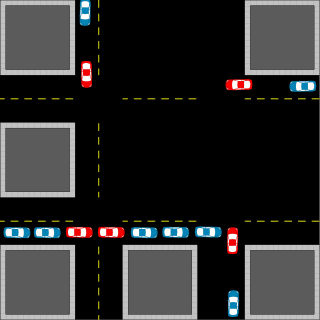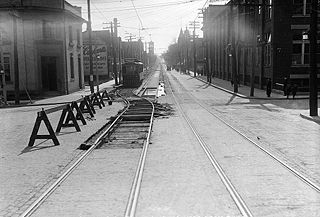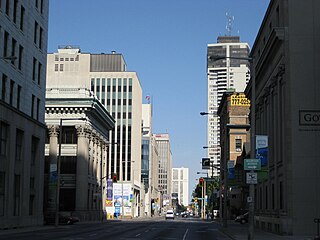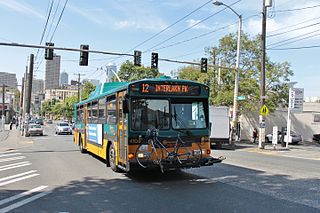Related Research Articles

Gridlock is a form of traffic congestion where "continuous queues of vehicles block an entire network of intersecting streets, bringing traffic in all directions to a complete standstill". The term originates from a situation possible in a grid plan where intersections are blocked, preventing vehicles from either moving forwards through the intersection or backing up to an upstream intersection.

The history of public transportation in Toronto in Canada dates back to the middle 19th century under many different private companies, organizations and owners, which were all later unified as a single government-run entity during the 1920s.

The 512 St. Clair is an east–west streetcar route in Toronto, Ontario, Canada, operated by the Toronto Transit Commission (TTC). It operates on St. Clair Avenue between St. Clair station on the Line 1 Yonge–University subway and Gunns Road, just west of Keele Street.

Samuel I. Schwartz, also known as Gridlock Sam, is an American transportation engineer, formerly the New York City Traffic Commissioner, notable for popularizing the phrase "gridlock".
The Relief Line was a proposed rapid transit line for the Toronto subway system, intended to provide capacity relief to the Yonge segment of Line 1 and Bloor–Yonge station and extend subway service coverage in the city's east end. Several plans for an east–west downtown subway line date back to the early 20th century, most of which ran along Queen Street.

Complete streets is a transportation policy and design approach that requires streets to be planned, designed, operated and maintained to enable safe, convenient and comfortable travel and access for users of all ages and abilities regardless of their mode of transportation. Complete Streets allow for safe travel by those walking, cycling, driving automobiles, riding public transportation, or delivering goods.

Streetcars or trolley(car)s were once the chief mode of public transit in hundreds of North American cities and towns. Most of the original urban streetcar systems were either dismantled in the mid-20th century or converted to other modes of operation, such as light rail. Today, only Toronto still operates a streetcar network essentially unchanged in layout and mode of operation.
Vision Zero is a multi-national road traffic safety project that aims to achieve a roadway system with no fatalities or serious injuries involving road traffic. It started in Sweden and was approved by their parliament in October 1997. A core principle of the vision is that "Life and health can never be exchanged for other benefits within the society" rather than the more conventional comparison between costs and benefits, where a monetary value is placed on life and health, and then that value is used to decide how much money to spend on a road network towards the benefit of decreasing risk.

A transit mall is a street, or set of streets, in a city or town along which automobile traffic is prohibited or greatly restricted and only public transit vehicles, bicycles, and pedestrians, and emergency services are permitted.

Toronto, Ontario, like many North American cities, has slowly been expanding its purpose-built cycling infrastructure. The number of cyclists in Toronto has been increasing progressively, particularly in the city's downtown core. As cycling conditions improve, a cycling culture has grown and alternatives such as automobiles are seen as less attractive. The politics of providing resources for cyclists, particularly dedicated bike lanes, has been contentious, particularly since the 2010s.

Northgate is a light rail and bus station in the Northgate neighborhood of Seattle, Washington, United States. It is the northern terminus of the 1 Line on Sound Transit's Link light rail system. The transit center, located adjacent to the Northgate Mall, has four bus bays served by 22 routes. The station also has parking for 1,525 vehicles.
Sue-Ann Levy is a Canadian writer and former political columnist for the Toronto Sun and Postmedia, who focused on municipal and social issues in Ontario. She has been described as 'unapologetically conservative', and has written Underdog: Confessions of a Right-Wing Gay Jewish Muckraker. Levy placed second in the 2009 Ontario by-election as Progressive Conservative candidate for Toronto, St. Paul's.

The Flexity Outlook is the latest model of streetcar in the rolling stock of the Toronto streetcar system owned by the Toronto Transit Commission (TTC). Based on the Bombardier Flexity, they were first ordered in 2009 and were built by Bombardier Transportation in Thunder Bay and Kingston, Ontario, with specific modifications for Toronto, such as unidirectional operation and the ability to operate on the unique broad Toronto gauge.

Cycling in Canada is experienced in various ways across a geographically huge, economically and socially diverse country. Among the reasons for cycling in Canada are for practical reasons such as commuting to work or school, for sports such as road racing, BMX, mountain bike racing, freestyle BMX, as well as for pure recreation. The amount and quality of bicycle infrastructure varies widely across the country as do the laws pertaining to cyclists such as bicycle helmet laws which can differ by province.
East Bayfront LRT, also known as the Waterfront East LRT, is a planned Toronto streetcar line that would serve the East Bayfront and Port Lands areas in Toronto, Ontario, Canada. It would run from Union station under Bay Street and along Queens Quay and Cherry Street to a new Villiers Island Loop along Commissioners Street east of Cherry Street. It would complement the existing 509 Harbourfront service that connects Union Station to Queens Quay west of Bay Street. Longer-term plans are to extend the East Bayfront line from Cherry and Commissioners Streets to the planned East Harbour Transit Hub along GO Transit's Lakeshore East line and the planned Ontario Line.

The Hamilton LRT is a planned light rail line in Hamilton, Ontario, Canada, to operate along Main Street, King Street, and Queenston Road. It is one of five planned rapid transit lines which form Hamilton's proposed BLAST network. The 14 km (8.7 mi), 17-stop route is planned to extend from McMaster University to Eastgate Square via downtown Hamilton.

The RapidRide G Line is a future RapidRide bus service in Seattle, Washington, operated by King County Metro on Madison Street between Downtown Seattle and Madison Valley. The line is projected to open for service in 2024 and cost $133.4 million.

Grace Crunican is a mass transportation specialist who most recently served as general manager of the San Francisco Bay Area Rapid Transit (BART) District. She had previously worked for the Oregon Department of Transportation, the Federal Transit Administration, and the Seattle Department of Transportation, and also at the mass transit lobbying organization called the Surface Transportation Policy Project.

The King Street Transit Priority Corridor is a transit mall located along King Street between Jarvis and Bathurst Streets in Toronto, Ontario, Canada. It passes by two subway stations on Line 1 Yonge–University. The corridor was created by the King Street Pilot Project to improve streetcar reliability on downtown King Street. The corridor went into operation on November 12, 2017, and was made permanent by City Council on April 16, 2019. The corridor is 2.6 km (1.6 mi) long and spans 18 street intersections.
Lawrence–Kennedy GO Station was a planned GO Transit train station to be built by Metrolinx under Lawrence Avenue in Toronto on the site of the existing Lawrence East station. Parking, a kiss and ride area, a bus loop, and pedestrian access from the Lawrence Avenue overpass will be provided. It was initially proposed as part of SmartTrack but was removed from the plan in January 2021.
References
- 1 2 3 Ben Spurr (2016-12-09). "Barbara Gray, the city's incoming director of transportation, comes to the job after a stint in Seattle". Toronto Star . Archived from the original on 2019-08-27. Retrieved 2019-08-20.
A 50-year-old Manhattan native, Gray comes to Toronto by way of Seattle, where she has worked in the public sector for 17 years, for the past two as deputy director of the department of transportation.
- ↑ "Barbara Gray overseees 5,000 km of roads, 7,000 km of sidewalks & 2,500 traffic signals". Toronto Savvy . 2017-01-10. Retrieved 2019-08-30.
SEATTLE's loss is TORONTO's gain as BARBARA GRAY becomes this city's new General Manager of Transportation (operating budget $400-million). At a time when pedestrian deaths are climbing, gridlock is an hourly occurrence and a battle royal is underway between bicyclists and motorists, Mrs. Gray will have her hands full.
- ↑ John Oakley (2018-03-19). "Barbara Gray, General Manager, Transportation Services, City of Toronto talks about several new initiatives to improve road safety". John Oakley Show . Retrieved 2019-08-30.
- ↑ Rahul Gupta (2016-12-27). "Q&A with new Toronto Transportation GM Barbara Gray". City Centre Mirror . Retrieved 2019-08-30.
My strategy is to meet people where they are at. I like to go out and be very engaged with communities and hear about problems they're trying to solve. There's always a scenario where plans and vision want to move faster than residents are comfortable with. Sometimes you have to move fast, especially when you're looking at equity. People who are the most dependent on walking and transit in particular, kids, seniors, people with disabilities, for me we have to make decisions (which benefit those groups). If the systems are reliable, more people will be willing to walk, bike or take transit, and the more space there is for people to drive or get goods to market.
- ↑ Sue-Ann Levy (2020-01-31). "Vision Zero has turned into another City Hall industry". Toronto Sun . Retrieved 2020-02-01.
The target, of course, is the car, so much so that one wonders if the goal of transportation general manager Barbara Gray is to drive cars completely off city streets.
- ↑ "Barbara Gray". University of Toronto Transportation Research Institute . 2019. Archived from the original on 2019-08-30. Retrieved 2019-08-30.
As Deputy Director of the Transportation Department in Seattle she led the development of the first city-wide Pedestrian Master Plan and Complete Streets policy and oversaw daily operations for policy, planning, and right of way management. She launched the plan to include a public realm activation program, a Project Coordination Office and a 24/7 Transportation Operations Center.
- ↑ Sue-Ann Levy (2019-07-17). "LEVY: Council sets wheels in motion for more gridlock". Toronto Sun . Archived from the original on 2019-07-19. Retrieved 2019-08-30.
City transportation czar Barbara Gray and municipal cycling guru Jacquelyn Hayward must have thought they died and went to heaven Wednesday. First council's pack of car haters gave them approval to lower speed limits down to horse-and-buggy pace on a variety of arterials Tuesday — as part of their Vision 2.0 plan.
- ↑ Sue-Ann Levy (2019-08-19). "LEVY: The war on the car road show, courtesy of Seattle". Toronto Sun . Archived from the original on 2019-08-21. Retrieved 2019-08-30.
'It is fair to say that there's a 'war on the cars' in Seattle,' says resident David Preston. 'That war ramped up considerably during Ms. Gray's tenure here.'
- ↑ John Rieti (2017-05-12). "4 high-profile transportation managers no longer with the City of Toronto". CBC News . Archived from the original on 2017-05-17. Retrieved 2019-08-30.
Gray's letter thanked all four for their "significant contribution" to the city and that the change was the result of realigning management. City spokesperson Wynna Brown declined to say why the managers are no longer working at the city.
- ↑ Eric Emin Wood (2017-12-18). "Toronto's transportation manager on the city's 2 digitally-driven traffic reduction pilot projects". IT Business . Archived from the original on 2018-02-18. Retrieved 2019-08-30.
That's when the first Split Cycle Offset Optimization Technique (SCOOT)-driven traffic control system was installed in Toronto. Designed to optimize traffic signal operations based on real-time traffic conditions, it was a boon at the time but is sorely in need of an update – which is why the city's transportation services division is running two pilot projects designed to choose a technology to replace them, manager Barb Gray told ITBusiness.ca during parent company ITWC's recent Technicity conference.